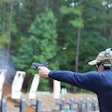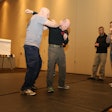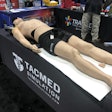Slicing through the rolling hills and quiet villages of Vermont's Upper Valley are the dual black-ribbon roadways of interstates 89 and 91. Stretching from the Canadian border into New Hampshire and Connecticut, respectively, the robust thoroughfares form the backbone for travel in western New England.
The roadways bring tens of thousands of vehicles, including 18-wheeler trucks hauling goods ranging from clothing to cattle, through the valley. Unfortunately, the roads also act as efficient conduits for illegal goods and all manner of nefarious persons-and essentially deliver crime right to the doorstep of the Hartford Police Department.
"What the interstates provide is a quick exit through our jurisdiction," says Hartford Police Chief Joseph Estey. "For us, the interstates are a corridor from the larger metro areas."
In addition to narcotics smuggling, other crimes brought Hartford's way via interstate include vehicle theft, illegal immigration, and retail-level drug distribution, especially for South American heroin. In 1984, serial killer Paul James Allen also plied his trade on I-91, killing a long-haul trucker at a highway rest stop.
Crime also arrives by bus and rail in Hartford. The village is a transportation hub for Vermont Transit, as well as Amtrak, which provides daily rail service from a variety of metropolitan cities, including Washington, D.C., and New York City.
The Hartford Police Department's 20 officers serve about 25,000 residents in five communities that form the Upper Valley. Each community has its own character and set of policing concerns. White River Junction is a working class town. Hartford and Wilder are mostly residential communities, and are impacted by events at nearby Dartmouth College. West Hartford is a farming community. Quechee, site of picturesque Quechee Gorge, is a tourist town-and, as it turns out, a popular spot for suicides.
Hartford itself is a charming New England community with a gentle lifestyle, low unemployment rate, and very little violent crime. The methamphetamine trade didn't make inroads here until this spring, when the department discovered a single meth cookhouse. Two homicides in a single year would constitute an epidemic.
"This is where I want my family to grow up," says Officer Karl Ebbighausen, who began his policing career 16 years ago, as part of the five-man Woodstock (Vt.) Police Department. "Within a three-hour drive, we have Boston; within four hours, New York City; and two hours to Montreal...yet we're still in a rural area, with incredible schools. It's a good place to raise a family."
Vermont is the nation's eighth smallest state, and Hartford PD is one of only 49 police agencies statewide. The department operates with a $2.1 million budget and services a 38-square-mile service area, giving it the highest road mileage of any municipal police department in the entire Green Mountain State. The policing ratio in the Upper Valley is 2.2 officers per 1,000 residents.
Hartford police officers deal with the same bread-and-butter incidents that every small police department does: citizen assistance calls, underage drinking, neighbor disputes, property crimes, truancy, and traffic violations. Officers conduct animal control response and community policing campaigns in the public school system. The Hartford PD also serves as the Identification Center for Windsor County, and operates one of seven public safety answering points for Vermont's Enhanced 911.
"We wear many hats here," notes Ebbighausen, who does quadruple duty as a patrol officer, shift coordinator, field training officer, and firearms instructor. "Basically, you're a jack of all trades, master of none."
Hartford PD is overseen by Estey, a 30-year policing veteran who has served as chief since 1987. He also serves as president of the 20,000-member International Association of Chiefs of Police, and he brings political, administrative, and financial savvy to the chief's position.
Estey's work is reflected in the fact that partly due to creative use of grant money, the department is one of the best-equipped in New England. Hartford PD's five marked Crown Vic patrol cars are replaced every two years, on average. Each one is equipped with an Automatic External Defibrillator, video camera, dual antenna radar unit, spike strips, and patrol rifle.
Perhaps the biggest challenge facing the department is keeping pace with a growing population. Although the entire population of Vermont numbers just 640,000, the village of Hartford is expected to double in size within the next 15 years.
"Most of the departments I know have not had a lot of growth (in manpower or salaries)," says Estey, who oversees Hartford PD's $2.1 million budget. "And yet the state and our population continue to grow."
Bryn Bailer is a former newspaper reporter and contributing editor for Police. She also works at the Tucson (Ariz.) Police Department as a civilian employee.















